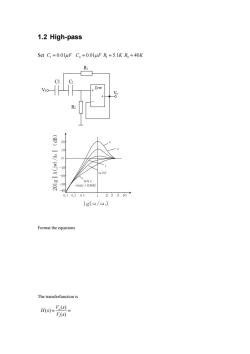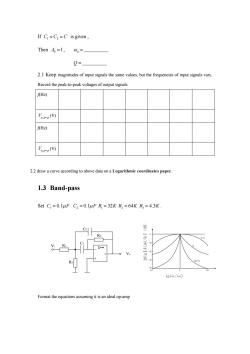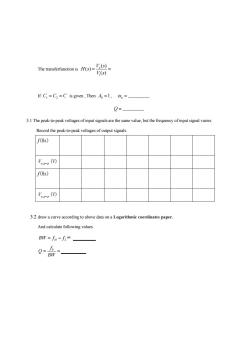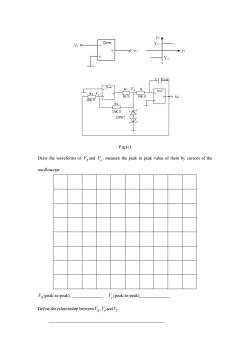《Electronics Lab》课程教学资源:Lab 07 & 08 filter、Function Generator

1 Lab 7 filter 1.1 Low-pass filter Analysis the circuit,assuming the op-amp is a ideal one,then 1.The currents into both input terminals are zero m+=0,n-=0 (1) This is due to infinite input resistance.An infinite resistance between the input terminals implies that an open circuit exits there and current cannot enter the op amp. 2.The voltage across the input terminals is negligibly small Vint =Vin- (2) SetC=0.047uFC2=0.0047uFR=10KR2=10K C1 For node 1 -'+a-'2+CsW。-V)=0 R R For node 2 (Va-Va)-CsVn=0 R Since it is ideal op-amp,there isV=V The transferfunction is
1 Lab 7 filter 1.1 Low-pass filter Analysis the circuit , assuming the op-amp is a ideal one , then l. The currents into both input terminals are zero 0; 0 in in i i (1) This is due to infinite input resistance. An infinite resistance between the input terminals implies that an open circuit exits there and current cannot enter the op amp. 2. The voltage across the input terminals is negligibly small in in v v (2) Set 1 C F 0.047 2 C F 0.0047 1 R 10K 2 R 10K . C1 R2 R1 C2 Vo Vi 1 2 Vn1 Vn2 For node 1 1 21 1 1 2 1 ( )( ) ( )0 in n n o n VV V V CsV V R R For node 2 1 2 2 2 1 ( ) 0 n n n V V C sV R Since it is ideal op-amp, there is V V n o 2 The transferfunction is

H(s)= '(s) V(s)(RRCC)s2+(R+R)C2s+1 1 RRCC2 (R+R)C.s+ 1 RRCC2 RCC2 Ao斤 s2+(@/Q)s+0 IR=R is given,Then1RCC 0- Let s=jo,the magnitude of the transfer function is called"voltage gain",often measured as the ratio of the peak-to-peak voltages 'op-pUo) H(jo-Tp-pOo) 10 0 0.707 -10 Q=0.5 20 -30 40 0.1 0.4123510 Ig(w/w.) 1.1 Keep magnitudes of input signals the same values,but the frequencies of input signals vary from DC to 3KHz.Record the peak-to-peak voltages of output signals. f(Hz) p-p(W f(Hz) Vp-p() 1.2 draw a curve according to above data on a Logarithmic coordinates paper
2 1212 1 2 2 1212 2 1 22 1212 1212 2 0 2 2 ( ) 1 ( ) () ( ) ( ) 1 1 ( ) 1 = ( ) o i n n n V s H s V s RRCC s R R C s RRCC R RC s s RRCC RRCC A s Qs If R1 2 R R is given ,Then 0 A 1, 1 2 1 n R CC 1 2 1 2 Q CC Let s j , the magnitude of the transfer function is called “voltage gain”,often measured as the ratio of the peak-to-peak voltages : 20 10 0 -10 -20 -30 -40 0.1 0.4 1 2 3 5 10 lg(ω/ωn) 20lg H(jw)/A0 dB 1 2 0.707 Q=0.5 , , ( ) ( ) ( ) op p ip p V j H j V j 1.1 Keep magnitudes of input signals the same values, but the frequencies of input signals vary from DC to 3KHz. Record the peak-to-peak voltages of output signals. f(Hz) Vop p , (V) f(Hz) Vop p , (V) 1.2 draw a curve according to above data on a Logarithmic coordinates paper

1.2 High-pass Set C =0.01uF C2=0.01uF R =5.1K R3=40K R (p)V/(A)V 8107 010 0 10 8 0.707 Q-0.5 40B/十倍频程 0.10.20.4 1 23510→ 1g(0/0) Format the equations The transferfunction is H(S)= V(= '(s)
1.2 High-pass Set 1 C F 0.01 2 C F 0.01 1 R 5.1K 2 R 40K Format the equations The transferfunction is ( ) ( ) ( ) o i V s H s V s

If C=C2=C is given, Then Ao=1, 0= 2.1 Keep magnitudes of input signals the same values,but the frequencies of input signals vary. Record the peak-to-peak voltages of output signals. Hz) V(V) AHz) (V) 2.2 draw a curve according to above data on a Logarithmic coordinates paper. 1.3 Band-pass Set C =0.1uF C,=0.1uF R =32K R =64K R3 =4.3K. =10 10 1g(@/0) Format the equations assuming it is an ideal op-amp
If CCC 1 2 is given , Then 0 A 1, n Q 2.1 Keep magnitudes of input signals the same values, but the frequencies of input signals vary. Record the peak-to-peak voltages of output signals. f(Hz) Vop p , (V) f(Hz) Vop p , (V) 2.2 draw a curve according to above data on a Logarithmic coordinates paper. 1.3 Band-pass Set 1 C F 0.1 2 C F 0.1 1 R 32K 2 R 64K R3 4.3K . Format the equations assuming it is an ideal op-amp

The transferfunction is H(s)= V.(s)= '(s) If C=C,=C is given,Then A=1,= O=_ 3.1 The peak-to-peak voltages of input signals are the same value,but the frequency of input signal varies. Record the peak-to-peak voltages of output signals f(Hz) 'ap-p(M f(Hz) Vp(V) 3.2 draw a curve according to above data on a Logarithmic coordinates paper. And calculate following values BW=fa-f=一
The transferfunction is ( ) ( ) ( ) o i V s H s V s If CCC 1 2 is given , Then 0 A 1, n Q 3.1 The peak-to-peak voltages of input signals are the same value, but the frequency of input signal varies. Record the peak-to-peak voltages of output signals. f(Hz) Vop p , (V) f(Hz) Vop p , (V) 3.2 draw a curve according to above data on a Logarithmic coordinates paper. And calculate following values BWf f H L = 0f Q BW

2 Lab 8 Function Generator 2.1 Sinusoidal signal generator R33K2C10.01uF o Vo 0.0luFC RW 10K2 R 33K 10K910K2 10K (a) R 33K9 C0.0luF oVo 0.0luFC Rw 10K2 R 33K R 10K210K 10K2 D2 (b) Step 1:adjust Ry to start oscillation while unloaded in Fig.(a). Step 2:Then do not change Ry any more. FIG(a) FIG(b) V(peak-to-peak,unloaded) V(peak-to-peak,Loaded with frequency (Hz)
2 Lab 8 Function Generator 2.1 Sinusoidal signal generator Step 1:adjust RW to start oscillation while unloaded in Fig.(a). Step 2: Then do not change RW any more. FIG.(a) FIG.(b) Vo (peak-to-peak,unloaded) Vo (peak-to-peak, Loaded with 1k frequency(Hz)

Vo◆ Vot C 0.luF R3 Va R RI V 3KQ 10KQ 0 Vo 10K2 R2 20KQ 2DW7 Fig.(c) Draw the waveforms of Veand V,measure the peak to peak value of them by cursors of the oscilloscope Va(peak-to-peak): V(peak-to-peak). Define the relationship betweenand
Vo 2DW7 R2 20KΩ R3 3KΩ 10KΩ R R1 10KΩ C 0.1uF VB VC Fig.(c) Draw the waveforms of VB and Vo , measure the peak to peak value of them by cursors of the oscilloscope. VB (peak-to-peak): Vo (peak-to-peak) Define the relationship betweenVB ,Vo andVC
按次数下载不扣除下载券;
注册用户24小时内重复下载只扣除一次;
顺序:VIP每日次数-->可用次数-->下载券;
- 《Electronics Lab》课程教学资源:Lab 05 & 06 op-amp:adder、Integrator & Differentiator.pdf
- 《Electronics Lab》课程教学资源:Lab 04 counters.pdf
- 《Electronics Lab》课程教学资源:Lab 03 Edged-triggered Flip-Flops.pdf
- 《Electronics Lab》课程教学资源:Lab 02 Decoder and demultiplexer.pdf
- 《Electronics Lab》课程教学资源:Lab 12&13 Feedback amplifiers.pdf
- 《Electronics Lab》课程教学资源:Lab 11 OBJECTIVES.pdf
- 《Electronics Lab》课程教学资源:Lab 01 Combinational Logic.pdf
- 上海交通大学:《微电子学概论》课程教学资源_图灵奖下的人类智力延伸——-计算、集成电路及应用.pdf
- 《微电子学概论》课程教学资源:用十分鐘瞭解《圖靈獎得主》的學術貢獻.pdf
- 《数字集成电路 Digital Integrated Circuit》课程教学资源(阅读资料)IC testing_Novel Applications of Deep Learning Hidden Features for Adaptive Testing.pdf
- 《数字集成电路 Digital Integrated Circuit》课程教学资源(阅读资料)IC testing_IC design-for-test and testability features.pdf
- 《数字集成电路 Digital Integrated Circuit》课程教学资源(阅读资料)IC testing_Design, Manufacturing & Test of Integrated Circuits in the Nanotechnology Era.pdf
- 《数字集成电路 Digital Integrated Circuit》课程教学资源(阅读资料)IC testing_DESIGN AND TESTING OF COMBINATIONAL LOGIC CIRCUITS USING BUILT IN SELF TEST SCHEME FOR FPGAs.pdf
- 《数字集成电路 Digital Integrated Circuit》课程教学资源(阅读资料)IC testing_An introduction to IC testing.pdf
- 《数字集成电路 Digital Integrated Circuit》课程教学资源(阅读资料)IC testing_3D DFT challenges and solutions.pdf
- 上海交通大学:《数字集成电路 Digital Integrated Circuit》课程教学资源(课程实验)Lab #1:HSPICE Simulation.pdf
- 上海交通大学:《数字集成电路 Digital Integrated Circuit》课程教学资源(课程实验)HSPICE SIMULATION.pdf
- 上海交通大学:《数字集成电路 Digital Integrated Circuit》课程教学资源(讲义)Introduction(Semiconductor processing).pdf
- 上海交通大学:《电路基础》课程教学资源(PPT课件)第二章 电路分析的基本方法 §2.8 回路分析法 §2.9 节点分析法.ppt
- 上海交通大学:《通信基本电路》课程教学资源(参考资料)Fundamental of Communication Circuits Lecture 1 Introduction.ppt
- 《Electronics Lab》课程教学资源:Lab 09 & 10 Transistor Amplifier.pdf
- 上海交通大学:《通信原理与实验 Principles and Experiments of Communications》课程教学资源(PPT讲稿)Intro.ppt
- 《通信原理与实验 Principles and Experiments of Communications》课程参考书:John G. Proakis Masoud Salehi《Fundamentals of Communication Systems》(Second Edition).pdf
- 《Measurement Systems:Application and Design》课程教学资源(扩展知识)A Brief History of Measurement Systems.pdf
- 《Measurement Systems:Application and Design》课程教学资源(扩展知识)Cross-Linked Gold Nanoparticles on Polyethylene:Resistive Responses to Tensile Strain and Vapors.pdf
- 上海交通大学:《Measurement Systems:Application and Design》课程教学资源(扩展知识)Strain rate-dependent tensile properties and dynamic electromechanical response of carbon nanotube fibers.pdf
- 上海交通大学:《Measurement Systems:Application and Design》课程教学资源(扩展知识)In the memorial of a great author.pdf
- 上海交通大学:《Measurement Systems:Application and Design》课程教学资源(课件讲稿)Chapter 01 Introduction.pdf
- 上海交通大学:《Measurement Systems:Application and Design》课程教学资源(课件讲稿)Chapter 02 Configuration and Functional Description.pdf
- 上海交通大学:《Measurement Systems:Application and Design》课程教学资源(课件讲稿)Chapter 03 Generalized performance characteristics of instruments.pdf
- 上海交通大学:《Measurement Systems:Application and Design》课程教学资源(课件讲稿)Chapter 04 Motion & Dimensional Measurement.pdf
- 上海交通大学:《Measurement Systems:Application and Design》课程教学资源(课件讲稿)Chapter 05 Force Torque and Shaft Power Measurement.pdf
- 上海交通大学:《Measurement Systems:Application and Design》课程教学资源(课件讲稿)Chapter 06 Pressure and Sound Measurement.pdf
- 上海交通大学:《Measurement Systems:Application and Design》课程教学资源(课件讲稿)Chapter 07 Flow Measurement.pdf
- 上海交通大学:《Measurement Systems:Application and Design》课程教学资源(课件讲稿)Chapter 08 Temperature and Heat-Flux Measurement.pdf
- 上海交通大学:《Measurement Systems:Application and Design》课程教学资源(课件讲稿)Chapter 09 Miscellaneous Measurements.pdf
- 上海交通大学:《Measurement Systems:Application and Design》课程教学资源(课件讲稿)Chapter 10 Manipulating Computing and Compensation Devices.pdf
- 上海交通大学:《Measurement Systems:Application and Design》课程教学资源(课件讲稿)Chapter 11 Data Transmission and Instrument Connectivity.pdf
- 西安电子科技大学:《电路分析基础》精品课程电子教案(PPT课件讲稿)第1章 电路的基本概念与定律.ppt
- 西安电子科技大学:《电路分析基础》精品课程电子教案(PPT课件讲稿)第2章 电阻电路的一般分析方法.ppt
